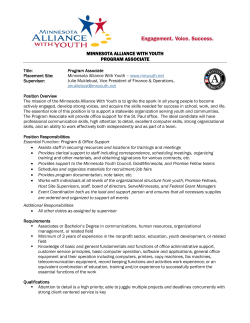
Read the Great Lakes Protection Act Alliance`s comments on Bill 66
Great Lakes Protection Act Alliance SUBMISSIONS REGARDING Bill 66 – PROPOSED GREAT LAKES PROTECTION ACT EBR REGISTRY NUMBER 012-‐3523 April 17, 2015 Laura Blease Senior Policy Advisor Ministry of the Environment Integrated Environmental Policy Division Land and Water Policy Branch 135 St. Clair Avenue West, Floor 6 Toronto, ON M4V 1P5 Cc: Gord Miller, Environmental Commissioner of Ontario SUMMARY The Great Lakes Protection Act Alliance is supportive of Bill 66, the proposed Great Lakes Protection Act. The Alliance has been engaged in all consultations that have been conducted regarding prior versions of the proposed legislation (specifically, Bill 100 introduced June 2012 and Bill 6 introduced February 2013) that died on the order paper. The Alliance believes that the proposed legislation introduces important new legal and policy tools to help safeguard, restore and protect Ontario’s portion of the Great Lakes-‐St. Lawrence River Basin. As the Alliance has stated in earlier submissions, strong and effective Great Lakes protection legislation has the potential to: 1 • • • • • • • Create the planning and regulatory tools necessary to better address the complex and challenging issues facing the Great Lakes now and in the future; Address legislative gaps in current Great Lakes policy; Provide mechanisms to track and measure progress on improving Great Lakes health and holding responsible authorities accountable; Create opportunities for stronger community involvement on Great Lakes issues; Affirm provincial commitment to meeting targets outlined in agreements with neighbouring Great Lakes-‐St. Lawrence River states and province and Canadian and US federal governments; Spark renewed interest in Great Lakes by focussing public attention and government resources on the urgency of the issues at hand; and Align priorities and decision-‐making across provincial ministries. The Alliance is very encouraged to see the strengthening of Bill 66 compared to the previous versions of the proposed legislation. In particular, the Alliance is very supportive of: • • • • • • • • • • Improved language in the Preamble, reflecting the importance of the Great Lakes-‐St. Lawrence River Basin; Additional language in purposes reflecting the importance of watersheds and the need to address climate change; Enhanced provisions related to promoting and considering traditional ecological knowledge in research and decision-‐making; Commitment to targets that will address algal blooms; Enabling the Minister of Natural Resources and Forests to set wetland target(s); Commitment to reducing or eliminating harmful pollutants; Incorporation of monitoring and reporting on ecological conditions; Increased accountability through addition of criteria development to prioritize geographically focussed initiatives (GFIs), the addition of principles and performance measures to the Strategy contents, commitment to consideration of purposes and principles in decision-‐making, and regular progress reports tabled in the Legislature; Enhanced public engagement through consultation prior to directing that a GFI proposal be developed, and allowing members of the public to bring forward requests to establish targets or GFIs; and Simplified, yet still rigorous, process for approving GFIs. The Alliance is extremely disappointed to see that, unlike the prior version of the proposed legislation, Bill 66 contains an exemptions provision. The sudden appearance of a broad discretionary power to prescribe exemptions from the legislation is very disconcerting. The Alliance believes that there are a few key amendments necessary to further strengthen the proposed legislation in order to ensure full realization of the province’s vision and provide for genuine and timely action to protect and restore Great Lakes-‐St. Lawrence River Basin health. These amendments, detailed below, are aimed at greater accountability and transparency in fully implementing this important new legislation. The Alliance reserves the right to further refine these recommendations before making submissions to the members of the Standing Committee that is directed by the Legislature to consider Bill 66. 2 Finally, as stated in earlier submissions, the Alliance recognizes that the problems facing the Great Lakes are complex and that a single piece of legislation cannot provide all of the answers. The Alliance considers Bill 66 to be one step on the path towards protecting human health while safeguarding the ecological integrity of the Basin in ways that are economically viable. Next steps need to include making full use of the tools provided in Bill 66, ensuring adequate budgets are allocated to implementation, applying integrated watershed management principles to decision-‐ making, and aligning Great Lakes policy to meet local, provincial, federal and international commitments. As the Preamble to Bill 66 states, “three of Ontario’s four Great Lakes are in decline.” We must act quickly to enact Bill 66 and make use of the new tools provided by the proposed legislation to address the loss and degradation of natural habitats and biodiversity, the impacts of population growth and urbanization, threats to water quality and quantity, including eutrophication, and climate change. This submission is authored by the following organizations as part of the Great Lakes Protection Act Alliance: Canadian Environmental Law Association, Theresa McClenaghan, Executive Director and Counsel Ducks Unlimited Canada, Kevin Rich, Provincial Policy Specialist Ecojustice, Pierre Sadik, Manager of Legislative Affairs Environmental Defence, Tim Gray, Executive Director Nature Canada, Ted Cheskey, Senior Conservation Manager Sierra Club Ontario, Dan McDermott, Chapter Director The Alliance wishes to acknowledge the assistance of Anastasia M Lintner of Lintner Law in drafting this submission. Endorsements The following organizations have endorsed this submission: Association for Canadian Educational Resources Alice Casselman BSc, M.Ed. Founding President Bay Area Restoration Council Chris McLaughlin, Executive Director 3 Bayfield Blue Community Project Ray Letheren Blue Mountain Watershed Trust Foundation Norman Wingrove, President Bonnechere River Watershed Project Kathryn Lindsay, PhD, Chair of the Board Canadian Association for Physicians of the Environment Gideon Forman, Executive Director Canadian Federation of University Women (CFUW) Ontario Council Brenda Robertson, President Citizens Environment Alliance of Southwestern Ontario Derek Coronado, Coordinator Citizens for a Safe Environment Karen Buck, President 4 Earthroots Josh Garfinkel, Senior Campaigner Ecologos Stan Gibson, Executive Director EcoWHam, Eco Churches of West Hamilton Wayne Poole [no logo] Federation of Ontario Cottagers’ Associations Terry Rees, Executive Director Freshwater Future Jill Ryan, Executive Director Freshwater Future Canada Jill Ryan, Executive Director Friends of the Bayfield River Ray Letheren [no logo] Friends of the Earth, Canada Beatrice Olivastri, CEO Friends of East Lake in Prince Edward County Linda Cole, President Georgian Bay Association Bob Duncanson, Executive Director 5 Grey Association for Better Planning Margaret J. Hutchison, Director Lake Huron Centre for Coastal Conservation Geoff Peach, Coastal Resources Manager Lake Ontario Waterkeeper Krystyn Tully, Vice President LEAF (Local Enhancement and Appreciation of Forests) Janet McKay, Executive Director Dr. Gail Krantzberg Professor and Director of the Centre for Engineering and Public Policy in the School of Engineering Practice McMaster University Muskrat Watershed Council Evelyn St. Amour, Interim Chair National Council of Women of Canada Denise Mattok, President Ontario Headwaters Institute Andrew McCammon, Executive Director 6 Ontario Rivers Alliance Linda Heron, Chair Ottawa Riverkeeper Meredith Brown, Riverkeeper and Executive Director Provincial Council of Women of Ontario Mary Potter, President Sustaining Tourism Dr. Rachel Dodds, Director/Owner Toronto Environmental Alliance Franz Hartman, Executive Director Wellington Water Watchers Mike Nagy, Chair World Wildlife Fund Canada James Snider, Acting Vice President, Freshwater Program © 1986 Panda symbol WWF-World Wide Fund For Nature (also known as World Wildlife Fund). ® “WWF” is a WWF Registered Trademark. 7 DETAILED RECOMMENDATIONS The Alliance believes that the language in Bill 66 should not be altered, except as recommended below. Our recommendations appear in the order that the relevant sections appear in Bill 66; no prioritization is intended or implied. The Alliance is happy to discuss our recommendations at your convenience. I. Further enhance purposes The Great Lakes-‐St. Lawrence River Basin provide essential habitat for nationally and globally significant concentrations of waterfowl and other waterbirds. Significant areas of congregation are recognized as part of the Important Bird and Biodiversity Areas program of BirdLife International. These areas are identified using internationally agreed upon, standardized, quantitative, and scientifically defensible criteria (see http://www.birdlife.org/datazone/info/ibacritglob). Natural coastal habitats and wetlands function as key stopovers and migratory corridors for significant numbers of migratory waterbirds and landbirds, bats, and migratory insects including Monarch Butterflies and dragonflies. Further, wetlands in the Basin are in crisis now. Further delays in putting effective wetland protection and restoration measures in place will only cause further wetland loss and degradation. To fully commit to the importance of natural habitats such as wetlands to the Basin, the Alliance recommends amending subsection 1(2) as follows: 2. To protect and restore watersheds, wetlands, beaches, shorelines and other coastal areas of the Great Lakes-‐St. Lawrence River Basin. 3. To protect and restore the natural habitats and biodiversity of the Great Lakes-‐St. Lawrence River Basin, including critical habitat areas for migratory birds, bats and insects such as Important Bird and Biodiversity Areas. 4. To protect and improve the capacity of the Great Lakes-‐St. Lawrence River Basin to respond to the impacts and causes of climate change, including by effectively managing urban and rural stormwater, promoting green infrastructure, and protecting and restoring wetlands. As well, a definition of “Important Bird and Biodiversity Areas” will need to be added to section 3: “Important Bird and Biodiversity Areas” means areas that have been identified by BirdLife International using internationally agreed upon, standardized, quantitative, and scientifically defensible criteria; II. Aligning pursuit of Great Lakes vision and goals To achieve the vision expressed in Ontario’s Great Lakes Strategy and the preamble and purposes of Bill 66, there will need to be alignment of the work of all Great Lakes ministries, in order to ensure that there is cross-‐ministerial accountability and efficient use of public resources. The Alliance proposes that the following section be added to Part III to ensure that all of the Great Lakes ministers are aligning their policies and programs with the Strategy: 8 5.1 Great Lakes ministers shall individually and severally pursue the achievement of the visions and goals established in the Strategy. III. Mandatory targets and “action plans” The Alliance is very supportive of the strengthened language in Part IV. As the Alliance has suggested in prior submissions, it is important the target setting in the proposed legislation be nondiscretionary. As well, it is important that there be targets set to reflect the various purposes of the legislation and the geographic differences throughout the Basin. Further, the Alliance believes that the new provision that envisions a plan to accompany a target must also be nondiscretionary. Finally, the Alliance reiterates that the need to address wetland loss is urgent. The case for strong wetland protection and restoration measures enabled within Bill 66 in order to prevent further wetland loss and sustain the Great Lakes is unequivocal. This case is further bolstered upon consideration of how stronger wetland protection and restoration measures would substantially advance several priorities of the Province, including: protecting species-‐at-‐risk and biodiversity, adapting to climate change, and safeguarding our water quality and water supply. “Reversing wetland loss” will require both stronger protection of remaining wetlands and rehabilitation or restoration of wetlands in areas that have suffered the greatest wetland loss and degradation, in order to ultimately increase the amount of wetland cover in Ontario. The Alliance recommends the following amendments to section 9: (2.1) Within a reasonable timeframe, the Minister shall ensure that at least one target is established under subsection (1) addressing each of the purposes in subsection 1(2). (3) The Minister of Natural Resources and Forestry may, after consulting with the other Great Lakes ministers, establish one or more qualitative or quantitative targets in respect of preventing the net loss of wetlands in all or part of the Great Lakes-‐St. Lawrence River Basin. … (5) With respect to a target the Minister of the Environment and Climate Change or the Minister of Natural Resources and Forestry has established under subsection (1) or (3), he or she the Minister may shall, after consulting with the other Great Lakes ministers, prepare a plan setting out the actions that may be taken to achieve the target. Also, remove references to the Minister of Natural Resources and Forestry in subsections (4) and (6). As well, to ensure clarity with respect to the addition of very limited responsibility delegated to the Minister of Natural Resources and Forestry, the Alliance recommends that a separate section be added after section 9: Targets Minister of Natural Resources and Forestry 9.1 (1) Within two years after this section comes into force, the Minister of Natural Resources and Forestry shall, after consulting with the other Great Lakes ministers, 9 establish one or more qualitative or quantitative targets in respect of reversing wetland loss in all or part of the Great Lakes-‐St. Lawrence River Basin. Targets, general (2) With respect to each target the Minister of Natural Resources and Forestry has established under subsection (1), he or she shall specify the area to which the target applies and the manner in which, in his or her opinion, public bodies with jurisdiction in that area should take it into consideration. Minister’s plans re targets (3) With respect to a target established under subsection (1), the Minister of Natural Resources and Forestry shall, after consulting with the other Great Lakes ministers, prepare a plan setting out the actions that may be taken to achieve the target. Minister’s directions re targets (4) The Minister of Natural Resources and Forestry may direct a public body or public bodies to do any of the following: 1. Provide the Ministry of Natural Resources and Forestry with any information specified in the direction to assist in establishing a target under subsection (1) or to assist in determining the actions required to achieve a target established under subsection (1). 2. Propose a target under subsection (1) to apply to an area specified in the direction by working together with other public bodies. 3. If the Minister has established a target under subsection (1) that is quantitative in nature, work together with other public bodies to propose how efforts to achieve the target should be divided within the area to which it applies. IV. Interjurisdictional agreements In section 33, three interjurisdictional agreements that relate to the protection and restoration of the ecological health of the Basin are included. There are other key interjurisdictional agreements to which Canada is also a party that are important to the protection and restoration of the ecological health of the Basin, including the Migratory Birds Convention, the Ramsar Convention and the Convention on Biological Diversity. For example, the Convention on Biological Diversity (CBD) commits the parties to “Integrate, as far as possible and as appropriate, the conservation and sustainable use of biological diversity into relevant sectoral or cross-‐sectoral plans, programmes and policies” (CBD, Article 6(b)). Ontario’s Great Lakes Strategy is a basin-‐wide vision that incorporates the input of the Great Lakes ministers and the Great Lakes community. As such, in reviewing the Strategy, consideration of the CBD commitment to integration is important. The Alliance recommends adding the following to section 33: 10 4. Migratory Birds Convention signed by Canada and the United States on August 16, 1916 and associated implementing legislation in Canada – the Migratory Birds Convention Act, 1994. 5. Convention on Wetlands of International Importance especially as Waterfowl Habitat, also known as the Ramsar Convention, entered into force in Canada on May 15, 1981. 6. Convention on Biological Diversity, adopted during the Earth Summit in Rio de Janeiro in 1992, ratified by Canada on December 29, 1993. V. Exemptions unnecessary As mentioned earlier, the Alliance is extremely disappointed to find that a provision has been added to allow Cabinet to prescribe exemptions from the legislation. The Alliance believes that there is no need to provide Cabinet with broad exemption powers from this enabling legislation. The Alliance strongly recommends that para 38(1)(l) be removed. (l) exempting any person or class of person from any provision of this Act or regulations, subject to such conditions or restrictions as may be prescribed by the regulations. 11
© Copyright 2025









